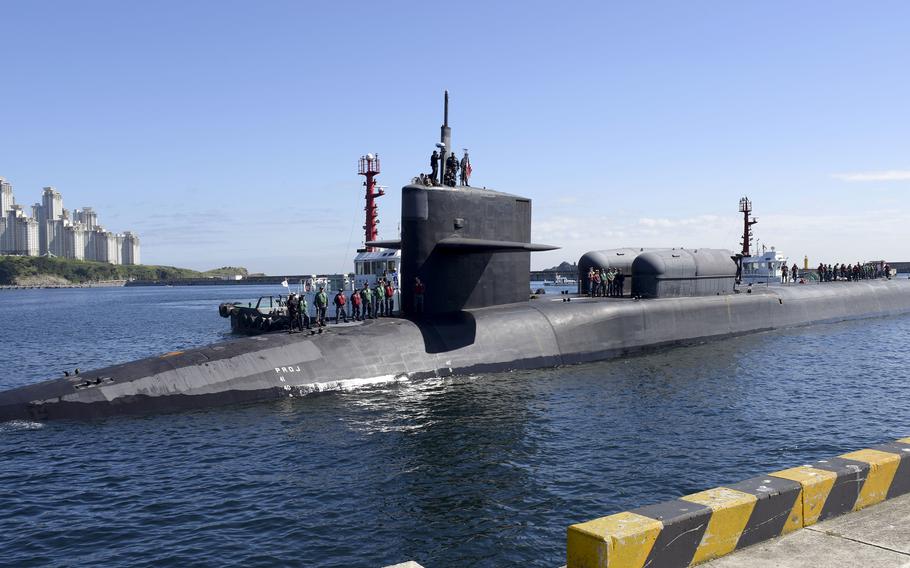
The nuclear-powered submarine USS Michigan pulls into a pier in Busan, South Korea, Friday, June 16, 2023. (William Carlisle/U.S. Navy)
CAMP HUMPHREYS, South Korea — One of the U.S. Navy’s largest submarines, the nuclear-powered USS Michigan, sailed into South Korea’s largest port Friday, less than a day after the North fired two short-range missiles.
The Michigan — an Ohio-class submarine with a capacity for 155 Tomahawk missiles — arrived “for the purpose of responding to North Korea’s advancing threats through joint special warfare exercises,” the South’s Ministry of National Defense said in a Friday news release.
The port visit also honors commitments between the United States and South Korea and “will further enhance the regular visibility of strategic assets” on the peninsula, South Korean Vice Adm. Kim Myung-soo said in the release.
The Michigan will stay in South Korean waters until an unspecified day in the following week, a South Korean navy spokesperson told Stars and Stripes by phone Friday. South Korean officials regularly speak to the media on a customary condition of anonymity.
The visit “reflects the United States’ commitment to the Indo-Pacific region,” the Navy’s Submarine Group 7 said in a news release Friday. It also complements the many exercises, training, operations and other military cooperation activities conducted by U.S. submarine forces with our [South Korean] allies,” according to the release.
U.S. Forces Korea and U.S. Naval Forces Korea did not immediately respond to a request for comment Friday; the commands regularly do not comment on military training in the Korean Peninsula, citing security concerns.
Ohio-class submarines are the largest ever built by the Navy. As ballistic missile submarines, they were designed to carry the nuclear-tipped Trident II D-5 missile, according to the Center for Strategic and International Studies.
But the Michigan and three other Ohio-class boats were converted to guided-missile submarines laden with Tomahawks, which can carry nuclear warheads “though policy decisions have phased out their nuclear role,” according to CSIS in February.
The Michigan last sailed into Busan in October 2017 for a routine visit during a scheduled deployment to the Western Pacific, the Navy said at the time. The vessel’s homeport is Naval Base Kitsap, Wash.
President Joe Biden and South Korean President Yoon Suk Yeol agreed in April to send a nuclear-armed ballistic missile submarine for a visit to the country at an unspecified date. The Michigan, however, is a guided-missile submarine.
Dubbed the Washington Declaration, the agreement promises Seoul and Washington will broaden their military and economic ties for the “shared goal of achieving the complete denuclearization of the Korean Peninsula.”
North Korea fired two short-range ballistic missiles off its eastern coast on Thursday. The missiles flew nearly 500 miles before landing in the East Sea, or the Sea of Japan, according to South Korea’s Joint Chiefs of Staff.
“We strongly condemn North Korea’s ballistic missile launch as a grave provocation that harms peace and stability on the Korean Peninsula, as well as the international community,” the Joint Chiefs said in a message to reporters on Thursday.
The launches were the North’s first since it failed to send a spy satellite into orbit on May 31. The rocket lost thrust during flight due to an “abnormal starting” of its engine, according to the South’s Defense Ministry.